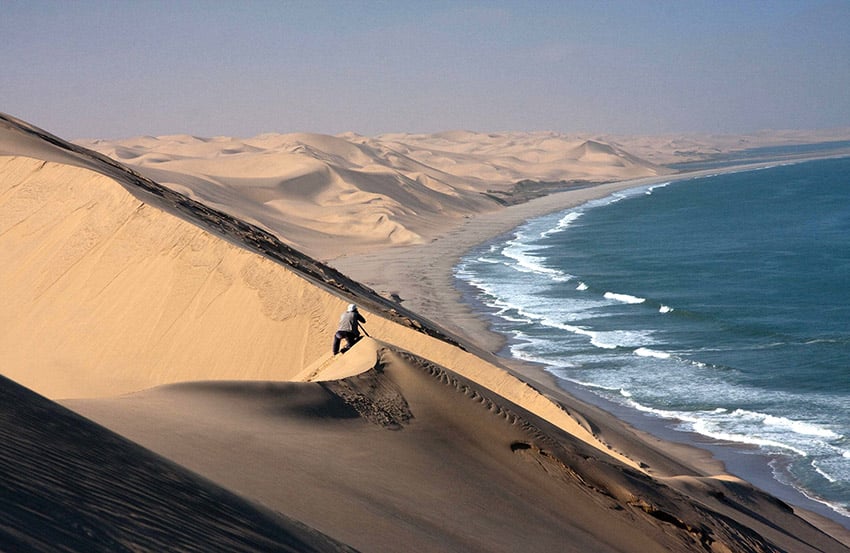The Dorob National Park is a protected coastal belt with unexpected desert treasures. The park, a 1600km strip of coast between the Kuiseb Delta and Ugab River, joins the Namib-Naukluft Park with the Skeleton Coast Park, and is an important link in the conservation of Namibia’s entire coastline.
Waterbird Haven
It includes the Walvis Bay lagoon, a RAMSAR site - a world-renowned wetland for the coastal birds that make their home on the western seaboard of Namibia or visit on their annual migratory routes. The plethora of waterbirds includes lesser and greater flamingos that line the shallow fringes in the wintertime. When there has been sufficient rainfall inland, they fly off to Etosha and the Makgadikgadi Pans to breed.

© Gondwana Collection
A turn for the better
The gravel plains south of Swakopmund are one of the largest known breeding sites for the ‘Near Threatened’ Damara tern Sternula balaenarum. Ninety-eight per cent of the population nests between the Orange and Kunene rivers. Threats to the survival of this small black-capped bird are from human disturbance and off-road vehicles. Areas have now been fenced-off to provide the population some protection.
Like no other
Lichen fields are visible along the roadside between Swakopmund and Henties Bay. This fascinating organism, a symbiosis between a fungus and an alga, depends on the moisture from the coastal fog for survival. Lichen colonies are slow-growing and easily destroyed by vehicles driving off-road. They are one of the Namib’s fragile species that is in dire need of protection.

© Ron Swilling
Cape Cross
A hundred and twenty kilometres north of Swakopmund is the spot where intrepid Portuguese explorer, Diogo Cão, erected a cross in 1486, calling the place Cabo do Padrão. Cão never made the trip home. He mysteriously disappeared from the pages of history, believed to have died in the mountains to the south-east, and his fleet set sail without him. Today, replicas of his cross mark the significant site.
Seals, seals & more seals
Cape Cross is also home to a large Cape fur seal colony. The Cape Cross Seal Reserve was proclaimed in 1968 to protect one of the largest Cape fur seal colonies on the southern African coastline. Enjoy a unique close-up view of the boisterous seal antics from the walkway.
%20web.jpg?width=850&height=590&name=Cape%20Cross_Ron%20Swilling%20(5)%20web.jpg)
© Ron Swilling
Fascinating facts
Although the desert may appear harsh and resilient, it is an extremely fragile environment. Off-road driving destroys populations of flora and fauna, and compacts the soil. The tracks remain visible on gravel plains for decades. There are ox-wagon tracks from over a century ago that are still visible today.
Cape fur seals are members of the Family Otariidae, comprising seals that have external earlobes.
Cape Cross was a hive of activity at the end of the 19th century attracting explorers, entrepreneurs and industry. It also boasted the first railway line (21km of track) and water distillation plant in the country - and the first postal robbery (the postman was accosted on the lonely road between Henties Bay and Swakopmund). In the first nine months of its existence, the Damaraland Guano Company exported 5 700 000kg of guano and 2 500 seal skins. The bustle and success at Cape Cross was short-lived; by 1903 the rocks had been stripped of guano and the seals had grown wary and were either difficult to cull or had left the area. After only nine years, a year before its concession expired, the company ceased operation (see also The intriguing tale of Cape Cross).

© Gondwana Collection
Traveller’s tips
Keep on existing tracks and resist the temptation to drive on the gravel plains. There may be more there than what is apparent, and the seemingly minor damage can be detrimental to the desert inhabitants.
Appreciate the serendipitous wonders of the desert.
Author: Ron Swilling
Do you feel like exploring Dorob National Park?
Contact the Gondwana Travel Centre to plan your trip.




.png?width=203&height=146&name=GTC%20LOGO-01%20(1).png)
SUBMIT YOUR COMMENT